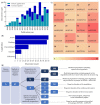Alpha-Lipoic Acid as an Antioxidant Strategy for Managing Neuropathic Pain
- PMID: 36552628
- PMCID: PMC9774895
- DOI: 10.3390/antiox11122420
Alpha-Lipoic Acid as an Antioxidant Strategy for Managing Neuropathic Pain
Abstract
Neuropathic pain (NP) is the most prevalent and debilitating form of chronic pain, caused by injuries or diseases of the somatosensory system. Since current first-line treatments only provide poor symptomatic relief, the search for new therapeutic strategies for managing NP is an active field of investigation. Multiple mechanisms contribute to the genesis and maintenance of NP, including damage caused by oxidative stress. The naturally occurring antioxidant alpha-lipoic acid (ALA) is a promising therapeutic agent for the management of NP. Several pre-clinical in vitro and in vivo studies as well as clinical trials demonstrate the analgesic potential of ALA in the management of NP. The beneficial biological activities of ALA are reflected in the various patents for the development of ALA-based innovative products. This review demonstrates the therapeutic potential of ALA in the management of NP by discussing its analgesic effects by multiple antioxidant mechanisms as well as the use of patented ALA-based products and how technological approaches have been applied to enhance ALA's pharmacological properties.
Keywords: alpha-lipoic acid; antioxidant; neuropathic pain; neuropathy; oxidative stress.
Conflict of interest statement
The authors declare no conflict of interest.
Figures




Similar articles
-
Pain Improvement With Novel Combination Analgesic Regimens (PAIN-CARE): Randomized Controlled Trial Protocol.JMIR Res Protoc. 2017 Jun 8;6(6):e111. doi: 10.2196/resprot.7493. JMIR Res Protoc. 2017. PMID: 28596150 Free PMC article.
-
Insights on the Use of α-Lipoic Acid for Therapeutic Purposes.Biomolecules. 2019 Aug 9;9(8):356. doi: 10.3390/biom9080356. Biomolecules. 2019. PMID: 31405030 Free PMC article. Review.
-
The Multifaceted Role of Alpha-Lipoic Acid in Cancer Prevention, Occurrence, and Treatment.Antioxidants (Basel). 2024 Jul 25;13(8):897. doi: 10.3390/antiox13080897. Antioxidants (Basel). 2024. PMID: 39199143 Free PMC article. Review.
-
A comprehensive review on alpha-lipoic acid delivery by nanoparticles.Bioimpacts. 2024;14(6):30136. doi: 10.34172/bi.2024.30136. Epub 2024 Feb 26. Bioimpacts. 2024. PMID: 39493899 Free PMC article. Review.
-
Combination Analgesic Development for Enhanced Clinical Efficacy (CADENCE Trial): Study Protocol for a Double-Blind, Randomized, Placebo-Controlled Crossover Trial of an Alpha-Lipoic Acid - Pregabalin Combination for the Treatment of Fibromyalgia Pain.JMIR Res Protoc. 2017 Aug 4;6(8):e154. doi: 10.2196/resprot.8001. JMIR Res Protoc. 2017. PMID: 28778847 Free PMC article.
Cited by
-
Assessing Gender Differences in Neuropathic Pain Management: Findings from a Real-Life Clinical Cross-Sectional Observational Study.J Clin Med. 2024 Sep 24;13(19):5682. doi: 10.3390/jcm13195682. J Clin Med. 2024. PMID: 39407742 Free PMC article.
-
Liquid- and Semisolid-Filled Hard Gelatin Capsules Containing Alpha-Lipoic Acid as a Suitable Dosage Form for Compounding Medicines and Dietary Supplements.Pharmaceutics. 2024 Jul 4;16(7):892. doi: 10.3390/pharmaceutics16070892. Pharmaceutics. 2024. PMID: 39065589 Free PMC article.
-
A narrative literature review about alpha-lipoic acid role in dry eye and ocular surface disease.Acta Ophthalmol. 2025 Sep;103(6):e346-e363. doi: 10.1111/aos.17486. Epub 2025 Apr 10. Acta Ophthalmol. 2025. PMID: 40207422 Free PMC article. Review.
-
Expert opinion on screening, diagnosis and management of diabetic peripheral neuropathy: a multidisciplinary approach.Front Endocrinol (Lausanne). 2024 Jun 17;15:1380929. doi: 10.3389/fendo.2024.1380929. eCollection 2024. Front Endocrinol (Lausanne). 2024. PMID: 38952393 Free PMC article. Review.
-
Antistress and Antiaging Potentials of Alpha-Lipoic Acid: Insights from Cell Culture-Based Experiments.Appl Biochem Biotechnol. 2024 Dec;196(12):8791-8808. doi: 10.1007/s12010-024-04994-4. Epub 2024 Jun 28. Appl Biochem Biotechnol. 2024. PMID: 38941028
References
-
- Raja S.N., Carr D.B., Cohen M., Finnerup N.B., Flor H., Gibson S., Keefe F.J., Mogil J.S., Ringkamp M., Sluka K.A., et al. The revised International Association for the Study of Pain definition of pain: Concepts, challenges, and compromises. Pain. 2020;161:1976–1982. doi: 10.1097/j.pain.0000000000001939. - DOI - PMC - PubMed
-
- Finnerup N.B., Haroutounian S., Kamerman P., Baron R., Bennett D.L.H., Bouhassira D., Cruccu G., Freeman R., Hansson P., Nurmikko T., et al. Neuropathic pain: An updated grading system for research and clinical practice. Pain. 2016;157:1599–1606. doi: 10.1097/j.pain.0000000000000492. - DOI - PMC - PubMed
-
- Dworkin R.H., O’Connor A.B., Audette J., Baron R., Gourlay G.K., Haanpaa M.L., Kent J.L., Krane E.J., Lebel A.A., Levy R.M., et al. Recommendations for the pharmacological management of neuropathic pain: An overview and literature update. Mayo Clin. Proc. 2010;85:S3–S14. doi: 10.4065/mcp.2009.0649. - DOI - PMC - PubMed
-
- Xu J., Wu S., Wang J., Wang J., Yan Y., Zhu M., Zhang D., Jiang C., Liu T. Oxidative stress induced by NOX2 contributes to neuropathic pain via plasma membrane translocation of PKCepsilon in rat dorsal root ganglion neurons. J. Neuroinflamm. 2021;18:106. doi: 10.1186/s12974-021-02155-6. - DOI - PMC - PubMed
Publication types
LinkOut - more resources
Full Text Sources
Miscellaneous

